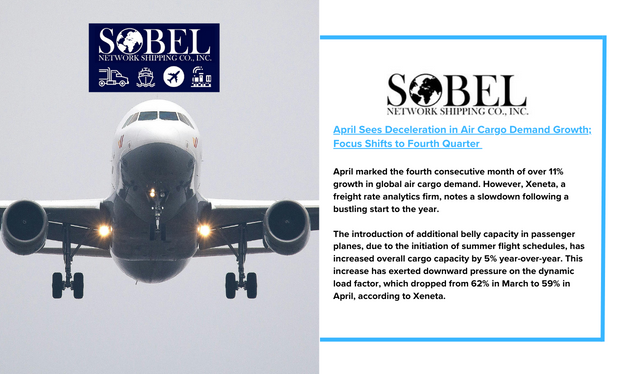April marked the fourth consecutive month of over 11% growth in global air cargo demand. However, Xeneta, a freight rate analytics firm, notes a slowdown following a bustling start to the year.
The introduction of additional belly capacity in passenger planes, due to the initiation of summer flight schedules, has increased overall cargo capacity by 5% year-over-year. This increase has exerted downward pressure on the dynamic load factor, which dropped from 62% in March to 59% in April, according to Xeneta.
Dynamic load factor, a metric developed by Xeneta, gauges cargo capacity utilization based on the volume and weight of cargo flown relative to available capacity.
Although the global air cargo spot rate initially rose in April, Xeneta cautions that this increase is unlikely to persist. For the first time since August 2022, the year-over-year growth of the global air cargo spot rate turned positive in April, increasing by 5%. This rise was fueled by conflicts in the Middle East and robust e-commerce demand, pushing the average global spot rate to $2.59 per kg—its highest point this year.
However, this growth is contextualized by a weak market in April 2023. “April could well be a pause leading into a quieter period for the airfreight market,” explained Niall van de Wouw, Chief Airfreight Officer at Xeneta. He highlighted that the spot rate increase was significantly driven by regional developments and market dynamics, typical of volatile market conditions.
With shipping disruptions in the Red Sea expected to diminish, demand for airfreight in regions like the Indian subcontinent, heavily impacted by these disruptions, is anticipated to lessen as businesses adapt to longer ocean freight lead times.
In regional specifics, the China to US market led April’s freight rate growth, soaring 20% month-on-month to $4.87 per kg. Similarly, rates from the Middle East and Central Asia to Europe and the US grew by about 18% month-on-month. Meanwhile, rates from Southeast Asia to Europe and the US also saw significant increases.
Conversely, the Europe to US market experienced a notable decline in freight rates, falling 8% month-on-month to $1.93 per kg.
As the fourth quarter approaches, shippers and forwarders are securing capacity in anticipation of another strong peak season, influenced by last year’s e-commerce demand. “There’s the reality of now, where load factor declines in markets because of increased capacity, alongside preparations for Q4, which is already in sight,” van de Wouw remarked.
Moreover, he noted a shift in contract strategies among shippers and forwarders, with a trend towards more short-term agreements to navigate ongoing market fluctuations effectively.
While forwarders aim for more extended contracts for better predictability and stability, airlines face a balancing act, deciding how much capacity to commit now versus what might yield up to 50% more revenue in a potentially busier Q4.


